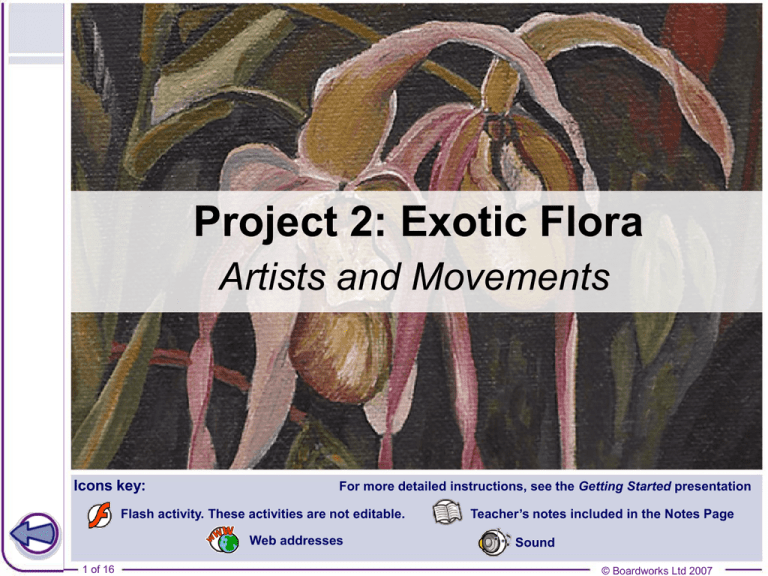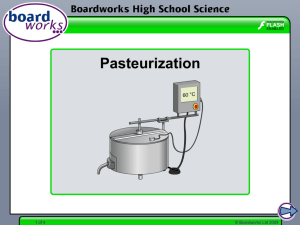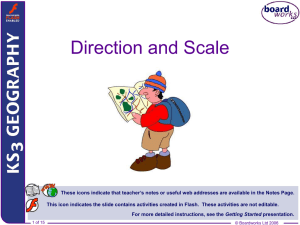William Morris – (powerpoint)
advertisement

Project 2: Exotic Flora Artists and Movements Icons key: For more detailed instructions, see the Getting Started presentation Flash activity. These activities are not editable. Web addresses 11 of of 16 16 Teacher’s notes included in the Notes Page Sound © Boardworks Ltd 2007 Learning objectives Who was William Morris? What influenced the work of William Morris? How can you create a repeating pattern in the style of William Morris? How can you print your design? 22 of of 16 16 © Boardworks Ltd 2007 Artists and movements Who created this image? What do you know about the artist? Seaweed Wallpaper Design, designed by William Morris (1834–96), printed by John Henry Dearle (1860–1932), 1901 3 of 16 © Boardworks Ltd 2007 William Morris William Morris was born in England in 1834 and died in 1896. He is widely known for his elaborate wallpaper and fabric designs, but he was also a poet, novelist, illustrator, architect and political thinker. He was a founder of the Arts and Crafts Movement which valued nature and craftsmanship over the mass production of the time. His designs are still being reproduced today and many artists have been influenced by his work. 4 of 16 © Boardworks Ltd 2007 The life and work of William Morris 5 of 16 © Boardworks Ltd 2007 What influenced William Morris? 6 of 16 © Boardworks Ltd 2007 William Morris designs This wallpaper is called Seaweed. It was hand printed by Morris’s design company. Look at the image carefully. What are the most important features? The design has a clear repeating pattern. The pattern is based on organic forms – there are no straight lines. There is a lot of detail. The colours are all muted greens and blues. Morris believed that beauty, imagination and order were the essential components of a successful design. 7 of 16 © Boardworks Ltd 2007 William Morris task Use what you have learned so far about the work of William Morris for this piece of work. 1. Stick an A4-sized copy of a Morris wallpaper design to one side of an A3-sized sheet of paper. 2. Extend the Morris design across onto the blank paper. 3. At first, try to make your additions as similar as possible to Morris’s pattern. As you progress across the page, use your imagination to change the colours and pattern. 4. Begin your design in pencil, then add colour, using coloured pencil or pens. 5. Use the examples on the following slide to help you. 8 of 16 © Boardworks Ltd 2007 William Morris inspired drawings Student gallery: William Morris inspired drawings. Students have studied a design by William Morris and used their imaginations to adapt and change the design. Criteria for success: imaginative organic shapes 9 of 16 clear colour scheme dense pattern texture and detail © Boardworks Ltd 2007 Create your own repeating wallpaper 10 of 16 © Boardworks Ltd 2007 William Morris printing Once you have created a repeating tile, you can reproduce it using a polyester, vinyl or other soft printing plate. Tape your design to a printing plate. Use a sharp pencil to prick through the design. Peel off the design. Using the pricks as a guide, create indentations onto the printing plate with a pencil. 11 of 16 © Boardworks Ltd 2007 William Morris printing Ink your printing plate using several thin layers of ink, rather than one thick one. The subtleties of your design will be lost if there is too much ink. Print your design onto paper, using a clean, dry roller to apply pressure to the back of your printing plate. You will need to apply your printing plate a number of times to create a larger repeating pattern. Take care to line the patterns up carefully! 12 of 16 © Boardworks Ltd 2007 William Morris printing Student gallery: William Morris inspired prints. To create multi-coloured prints, cut out sections of your printing block and add extra detail before printing on top of your original print. 13 of 16 © Boardworks Ltd 2007 Other artists Other artists who have used exotic flora as an inspiration include: Imogen Cunningham Karl Blossfeldt Tina Modotti Donna Schaffer Ruth Moilliet Olivia Parker Henri Rousseau 14 of 16 © Boardworks Ltd 2007 Key vocabulary You should understand all of the techniques and materials listed below. Create a glossary in the back of your sketchbook, listing these words and their meanings. Repeating pattern Printmaking Design Printing plate Printing ink 15 of 16 © Boardworks Ltd 2007 Useful websites The life and works of William Morris: http://www.morrissociety.org/ http://www1.walthamforest.gov.uk/wmg/ http://www.vam.ac.uk/collections/furniture/Wallpaper/ William_Morris/index.html Tiling and tessellation: http://www.cromp.com/tess/ http://www.tessellation.info/?open=general/artistinfo. php&lang=english&style=layout&people_ID=5 16 of 16 © Boardworks Ltd 2007





![Direction_and_Scale[1]](http://s2.studylib.net/store/data/005432475_1-80ce3065f13008250a8cdec135db9846-300x300.png)



